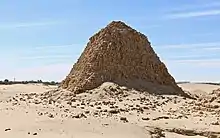| Karkamani | ||||||||||||||||||||||||
|---|---|---|---|---|---|---|---|---|---|---|---|---|---|---|---|---|---|---|---|---|---|---|---|---|
| Karkamani | ||||||||||||||||||||||||
 Karkamani's pyramid, Nuri, Sudan | ||||||||||||||||||||||||
| Pharaoh | ||||||||||||||||||||||||
| Reign | c. 519–510 BC | |||||||||||||||||||||||
| Predecessor | Amaninatakilebte | |||||||||||||||||||||||
| Successor | Amaniastabarqa | |||||||||||||||||||||||
| ||||||||||||||||||||||||
| Burial | Nuri (Nu. 7) | |||||||||||||||||||||||
Karkamani was a Meroitic king who ruled in the 6th century, probably between 519 to 510 BC at Napata. He succeeded King Amaninatakilebte and was in turn succeeded by King Amaniastabarqa.[1] Like others of his dynasty, he was discovered buried among the pyramid chambers at Nuri, specifically Nuri 7.[2]
References
This article is issued from Wikipedia. The text is licensed under Creative Commons - Attribution - Sharealike. Additional terms may apply for the media files.
